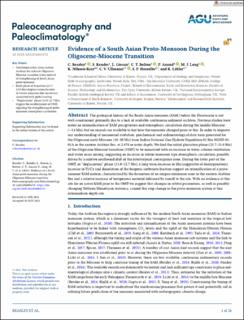| dc.contributor.author | Beasley, C. | |
| dc.contributor.author | Kender, S. | |
| dc.contributor.author | Giosan, L. | |
| dc.contributor.author | Bolton, C.T. | |
| dc.contributor.author | Anand, P. | |
| dc.contributor.author | Leng, M.J. | |
| dc.contributor.author | Nilsson-Kerr, Katrina | |
| dc.contributor.author | Ullmann, Clemens V. | |
| dc.contributor.author | Hesselbo, Stephen P. | |
| dc.contributor.author | Littler, Kate | |
| dc.date.accessioned | 2022-04-04T11:42:14Z | |
| dc.date.available | 2022-04-04T11:42:14Z | |
| dc.date.created | 2022-02-03T15:33:03Z | |
| dc.date.issued | 2021 | |
| dc.identifier.issn | 2572-4517 | |
| dc.identifier.uri | https://hdl.handle.net/11250/2989590 | |
| dc.description.abstract | The geological history of the South Asian monsoon (SAM) before the Pleistocene is not well-constrained, primarily due to a lack of available continuous sediment archives. Previous studies have noted an intensification of SAM precipitation and atmospheric circulation during the middle Miocene (∼14 Ma), but no records are available to test how the monsoon changed prior to this. In order to improve our understanding of monsoonal evolution, geochemical and sedimentological data were generated for the Oligocene-early Miocene (30–20 Ma) from Indian National Gas Hydrate Expedition 01 Site NGHP-01-01A in the eastern Arabian Sea, at 2,674 m water depth. We find the initial glaciation phase (23.7–23.0 Ma) of the Oligocene-Miocene transition (OMT) to be associated with an increase in water column ventilation and water mass mixing, suggesting an increase in winter monsoon type atmospheric circulation, possibly driven by a relative southward shift of the intertropical convergence zone. During the latter part of the OMT, or “deglaciation” phase (23.0–22.7 Ma), a long-term decrease in Mn (suggestive of deoxygenation), increase in Ti/Ca and dissolution of the biogenic carbonate fraction suggest an intensification of a proto-summer SAM system, characterized by the formation of an oxygen minimum zone in the eastern Arabian Sea and a relative increase of terrigenous material delivered by runoff to the site. With no evidence at this site for an active SAM prior to the OMT we suggest that changes in orbital parameters, as well as possibly changing Tethyan/Himalayan tectonics, caused this step change in the proto-monsoon system at this intermediate-depth site. | en_US |
| dc.language.iso | eng | en_US |
| dc.publisher | Wiley | en_US |
| dc.rights | Navngivelse 4.0 Internasjonal | * |
| dc.rights.uri | http://creativecommons.org/licenses/by/4.0/deed.no | * |
| dc.title | Evidence of a South Asian Proto-Monsoon During the Oligocene-Miocene Transition | en_US |
| dc.type | Journal article | en_US |
| dc.type | Peer reviewed | en_US |
| dc.description.version | publishedVersion | en_US |
| dc.rights.holder | Copyright 2021. The Authors | en_US |
| dc.source.articlenumber | e2021PA004278 | en_US |
| cristin.ispublished | true | |
| cristin.fulltext | original | |
| cristin.qualitycode | 1 | |
| dc.identifier.doi | 10.1029/2021PA004278 | |
| dc.identifier.cristin | 1997488 | |
| dc.source.journal | Paleoceanography and Paleoclimatology | en_US |
| dc.identifier.citation | Paleoceanography and Paleoclimatology. 2021, 36 (9), e2021PA004278. | en_US |
| dc.source.volume | 36 | en_US |
| dc.source.issue | 9 | en_US |

